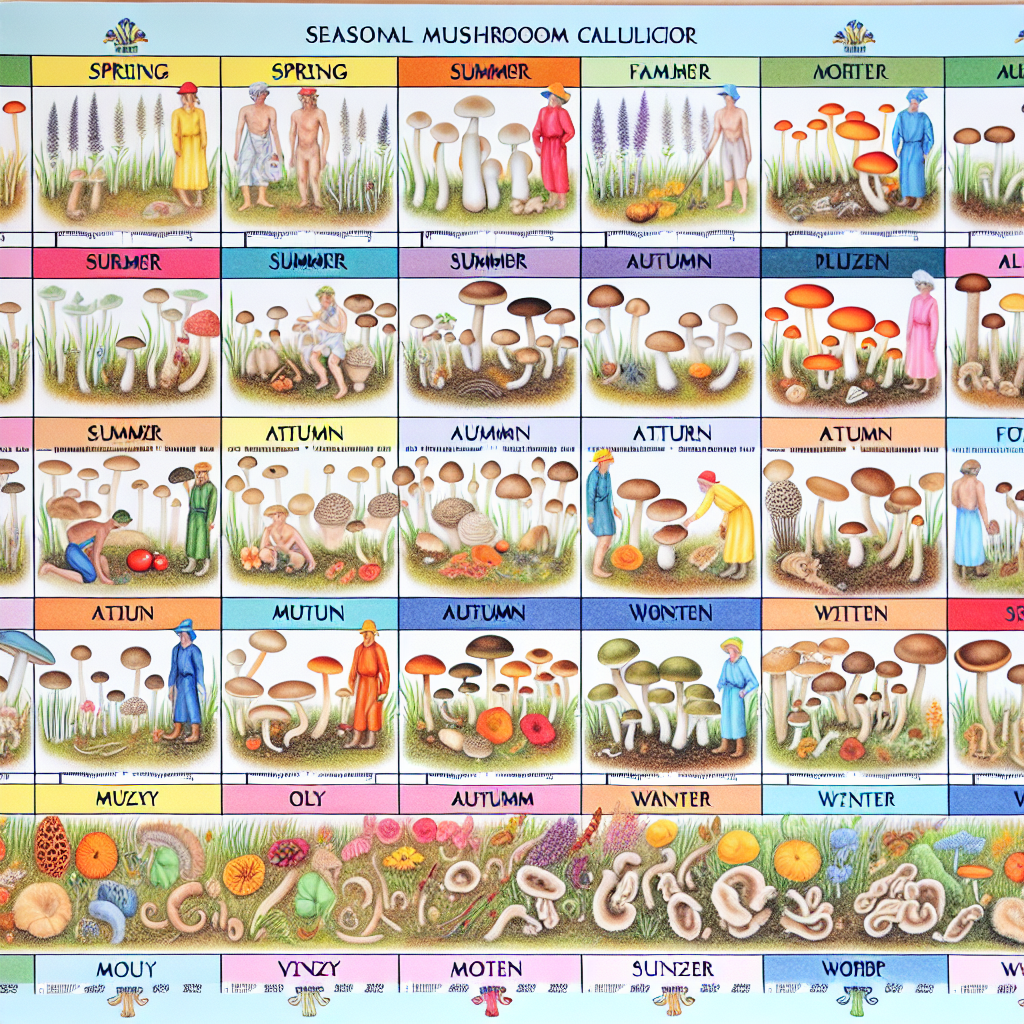Seasonal Mushroom Cultivation Calendar: Optimizing Year-Round Production
Mushroom cultivation is flourishing across recreational and medicinal markets, as interest in functional fungi like Lion’s Mane, Reishi, and Turkey Tail grows rapidly. However, despite rising demand, many growers struggle to maintain consistent yields due to seasonal variances in temperature, humidity, and light.
A carefully planned Seasonal Mushroom Cultivation Calendar is the ultimate tool to help home cultivators and commercial growers alike optimize production throughout the year. From reducing contamination to improving yields and ensuring therapeutic potency, aligning mushroom varieties with seasonal cycles is essential to success.
Let’s get into how and why a seasonal approach can transform your operation!
🌱 Why a Seasonal Cultivation Calendar is a Game-Changer
Unlike plants that rely heavily on sunlight and soil, mushrooms depend on precise environmental control—making seasonal variability a critical factor in the success of any grow project. Home growers and commercial operations often overlook how changing temperatures, humidity, and daylight hours impact colonization and fruiting.
With a seasonal calendar, growers can:
– Select strains best suited for current or upcoming climate conditions
– Increase crop success and reduce waste
– Improve space utilization and resource efficiency
– Maximize the therapeutic and nutritional potential of each mushroom type
For example, cold-tolerant species like Lion’s Mane thrive in winter, while summer’s warm, moist conditions are perfect for tropical mushrooms like Pink Oyster and Reishi.
🔬 Scientific Evidence Backing Seasonal Strategies
Recent scientific research provides solid evidence for seasonally-aligned mushroom cultivation. Here’s how studies confirm that tailoring your grow calendar pays off in both quality and quantity.
– 🐚 Oyster Mushrooms: A study in the Journal of Scientific and Industrial Research showed that Pleurotus ostreatus grown in cooler months led to higher nutrient retention and longer shelf life.
– 🧠 Lion’s Mane (Hericium erinaceus): Cooler temperatures increase the production of erinacines and hericenones—bioactive compounds known for supporting brain health. Read Study
– 💪 Reishi (Ganoderma lucidum): Higher humidity and warm temps enhance triterpenoid concentrations, which elevate this mushroom’s adaptogenic and immune-supporting potency. Read Study
– 🌾 Substrate & Colonization: Substrate performance and colonization speed vary by temperature. Warmer months reduce colonization time in mushrooms like Shiitake and Oyster, decreasing contamination risk. Read Study
– 📊 Bioactive Consistency: Seasonal fluctuations impact compound concentrations in mushrooms like Cordyceps and Turkey Tail. Timing your grows ensures potency and consistency for medicinal applications. Read Study
📆 Year-Round Cultivation Calendar: What to Grow and When
Timing is everything—and planning your grow cycles around the seasons can skyrocket both success and sustainability. Use this quick guide to align your production with nature’s rhythm.
❄️ Winter (December–February)
– Best Species: Lion’s Mane, Enoki, Shiitake
– Temperature Range: 10–18°C
– Notes: Slower growth but higher medicinal compound production. Perfect for producing powerful therapeutic batches.
🌸 Spring (March–May)
– Best Species: Shiitake, Oyster
– Temperature Range: 15–22°C
– Notes: Great for both indoor and early outdoor cultivation. Optimal humidity supports strong mycelium runs.
☀️ Summer (June–August)
– Best Species: Pink Oyster, Reishi, Cordyceps
– Temperature Range: 20–30°C
– Notes: High contamination risk calls for strict sterile procedures. Ideal for rapid colonization and warm-weather yields.
🍂 Autumn (September–November)
– Best Species: Turkey Tail, early Lion’s Mane, Shiitake
– Temperature Range: 15–20°C
– Notes: Transition season for cooling weather. Strong choice for starting winter crops and second harvests.
**Pro Tip:** Plan your substrate prep, spawning, and lab operations in advance to align with each seasonal wave. This ensures strong fruiting, avoids climate-induced stress, and reduces downtime.
🌿 Stay Competitive with Seasonal Growing in the Medicinal Market
The mushroom industry is booming—and much of this growth is driven by rising demand for functional fungi in health, wellness, and clinical care settings. With integrative medicine and nutritional supplementation on the rise, cultivators who offer consistent, high-quality mushrooms year-round have a clear competitive edge.
By optimizing compound concentrations through seasonal growing:
– Lion’s Mane extracts can be produced when erinacine levels are highest
– Reishi and Turkey Tail can be harvested for peak adaptogenic impact
– Cordyceps can meet rising athletic and immune support demands during flu season
When grown strategically, your therapeutic yield matches clinical demand—not just growing cycles. For home growers and micro-farms, this is key to product quality. For large-scale or clinical-grade growers, it’s the secret to staying ahead of the curve.
✅ Conclusion: Grow Smart, Grow Seasonal
A Seasonal Mushroom Cultivation Calendar is more than just a guide—it’s a blueprint for success. Whether you’re cultivating mushrooms for personal wellness, community health initiatives, or the far-reaching supplement industry, aligning your grows with seasonal conditions ensures consistency, potency, and quality.
Grow smarter by working with nature’s timeline, not against it—and enjoy fresh, functional, and therapeutic mushrooms all year round.
📚 References
– [Seasonal Variability in Mushroom Cultivation](https://nopr.niscpr.res.in/handle/123456789/42350)
– [Neuroprotective Effects of Hericium erinaceus](https://www.ncbi.nlm.nih.gov/pmc/articles/PMC5987239/)
– [Optimal Conditions for Reishi Cultivation](https://academic.oup.com/femsle/article/229/1/125/505401)
– [Substrate and Environmental Impacts on Yield](https://pubs.acs.org/doi/abs/10.1021/jf011579x)
– [Seasonal Changes and Medicinal Compounds](https://www.frontiersin.org/articles/10.3389/fphar.2020.00288/full)
Concise Summary:
Cultivating mushrooms year-round requires strategic planning to optimize yields, quality, and therapeutic potency. By aligning mushroom varieties with seasonal temperature, humidity, and light conditions, growers can increase success, reduce waste, and produce consistent, high-quality crops for the booming medicinal and wellness markets.

Dominic E. is a passionate filmmaker navigating the exciting intersection of art and science. By day, he delves into the complexities of the human body as a full-time medical writer, meticulously translating intricate medical concepts into accessible and engaging narratives. By night, he explores the boundless realm of cinematic storytelling, crafting narratives that evoke emotion and challenge perspectives. Film Student and Full-time Medical Writer for ContentVendor.com




